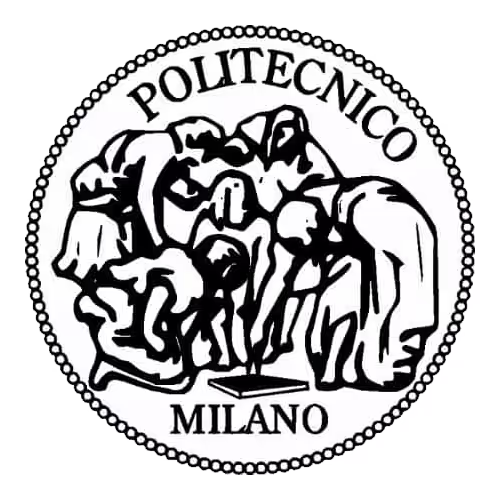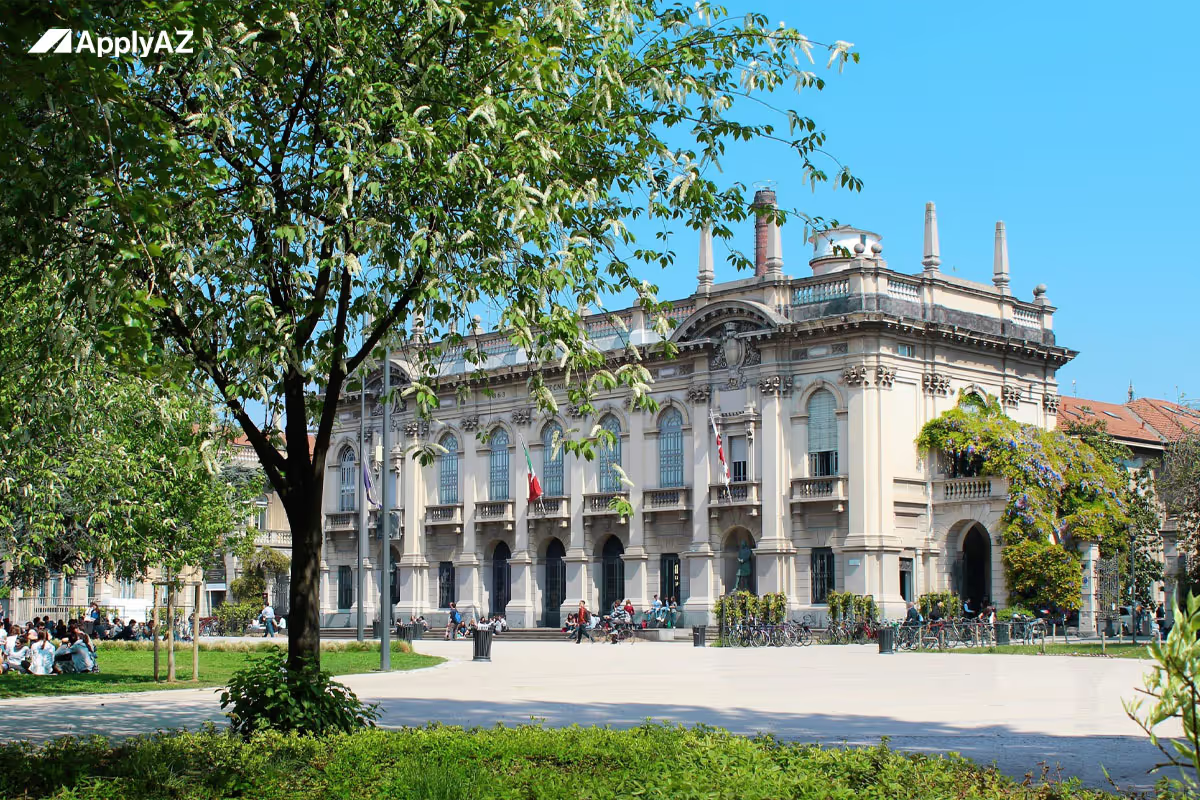Heading
Heading








Study in Italy in English at Polytechnic University of Milan (Politecnico di Milano)
Finding the right place to study in Italy in English can be hard. Yet one name always rises to the top: the Polytechnic University of Milan (Politecnico di Milano). This public Italian university blends 160 years of academic strength with the creative energy of Milan. Below, ApplyAZ explains its history, rankings, scholarships, jobs, and daily life so you can decide if it matches your goals.
A Public Italian University with World-Class Credentials
Politecnico di Milano opened in 1863 and now enrols more than 48 000 students on seven campuses across Lombardy. It ranks close to the world’s top 100 overall, top ten for design, and top twenty for engineering. These results reflect constant investment in staff, laboratories, and international partnerships.
Timeline of Excellence
- 1863: Founded as the Regio Istituto Tecnico Superiore with 30 students.
- 1900–1950: Expanded into civil and mechanical engineering.
- 1960s: Bovisa campus opened; architecture and design schools launched.
- 2000s: English-language master’s degrees introduced to welcome global talent.
- 2020s: Research centres in sustainable mobility, artificial intelligence, and space engineering became European hubs.
Key Departments and Facilities
- Architecture, Urban Planning, Construction Engineering – pioneers in sustainable cities and heritage preservation.
- Design – renowned for product, fashion, and interaction design, tied to Milan Design Week.
- Industrial and Information Engineering – covers aerospace, mechanical, biomedical, automation, and computer science.
- PoliFAB – flagship micro- and nanotechnology laboratory open to start-ups.
- Leonardo Supercomputer Hub – one of Europe’s fastest, supporting climate models and AI research.
The breadth of English-taught programs in Italy offered here lets you combine robotics with medical imaging or architecture with urban sociology. Many courses include double-degree options that add a second diploma abroad without extra fees—rare even among tuition-free universities Italy.
Campus Life and Student Support
Politecnico’s main centres—Città Studi and Bovisa—sit 15 minutes apart by metro. Both mix lecture halls with green courtyards, cafés, and maker spaces. The Welcome Desk guides new students through residence permits, bank accounts, and free Italian courses.
Sports fans find gyms, climbing walls, and five-a-side football pitches, while 100+ clubs cover robotics, Formula Student racing, photography, and debate. A buddy programme pairs newcomers with senior volunteers who help with day-to-day questions.
Milan: A City That Combines History, Creativity, and Career Growth
Milan offers historic elegance and future-focused energy. The city is compact, efficient, and rich in culture, making it ideal for international students.
Climate and Transport
- Mild winters: Average 5 °C in January.
- Warm summers: Around 30 °C in July.
- Affordable transport: A discounted student pass covers metro, tram, and bus for roughly €25 per month.
- Fast connections: High-speed trains reach Rome in three hours; airports offer flights to 200 destinations.
Cost of Living (Typical Monthly Budget)
- Shared flat near campus: €450–600
- University residence with DSU grant: €300–350
- Groceries: €45–60
- Subsidised campus meal: €4
- Mobile and internet: €15
Smart planning keeps total yearly costs below €8 000—especially after fee waivers and the DSU grant.
Student Life and Culture
Evenings can mean jazz in Navigli, gallery openings in Brera, or football at San Siro. Weekends bring skiing in the Alps, sailing on Lake Como, or city trips across Europe. Politecnico’s clubs—and Milan’s international vibe—make it easy to build a global network.
Funding Your Studies: Tuition Waivers and Scholarships
Politecnico di Milano charges variable tuition based on family income. Annual fees range from €0 to about €3 900. Most ApplyAZ students secure large reductions by submitting the ISEE (household income form).
The DSU Grant
The DSU grant, a regional scholarship for international and Italian students, offers:
- Full or partial fee waiver
- Meal vouchers for campus canteens
- Rent support
- Up to €5 200 cash each year
Jobs and Internships in Europe’s Design and Tech Hub
Milan drives Italy’s economy. More than 3 000 multinationals and 2 100 start-ups base their Italian or European offices here. Key sectors include fashion and luxury, design, finance and fintech, technology and AI, automotive and aerospace, green energy, and biomedical devices.
Politecnico’s career service hosts two large fairs each year, runs a job portal with 7 000 listings, and supports new ventures through PoliHub—Italy’s leading university incubator. Internships often pay €700–1 200 per month and count towards your degree. Graduates may convert their residence permit into a “job-seeking visa,” giving 12 months to find full-time work.
Living and Learning Across Multiple Campuses
- Città Studi: Historic centre for civil, chemical, and environmental engineering.
- Bovisa: Modern site with design studios, wind tunnels, and micro-electronics clean rooms.
- Piacenza, Lecco, Mantova, Cremona, Como: Smaller hubs perfect for focused research and lakeside relaxation.
In two minutes we’ll confirm whether you meet the basic entry rules for tuition-free, English-taught degrees in Italy. We’ll then quickly see if we still have space for you this month. If so, you’ll get a personalised offer. Accept it, and our experts hand-craft a shortlist of majors that fit your grades, goals, and career plans. Upload your documents once; we submit every university and scholarship application, line up multiple admission letters, and guide you through the visa process—backed by our admission-and-scholarship guarantee.
Civil Engineeringat Polytechnic University of Milan (Politecnico di Milano)
Dreaming of a high-impact engineering career? The Civil Engineering (L-7) bachelor at the Polytechnic University of Milan (Politecnico di Milano) lets you study in Italy in English, join one of the best English-taught programs in Italy, and enjoy the financial advantages of tuition-free universities Italy. Below, ApplyAZ guides you through the course, the city, funding, and careers so you can decide if this public Italian university is your perfect match.
World-Class University, International Outlook
Founded in 1863, Politecnico di Milano is Italy’s oldest and largest technical university. More than 48 000 students study at seven campuses, and the institution ranks in the global top twenty for engineering. The Civil Engineering – L-7 bachelor benefits from:
- Complete English delivery. Lectures, labs, exams, and the final thesis run in English, so a CEFR B2 certificate is enough to start.
- Cutting-edge facilities. You work with earthquake shake tables, 3-D concrete printers, wind tunnels, and virtual-reality design suites.
- Strong industry links. Guest lecturers from Webuild, AECOM, and Arup set design challenges that mirror real projects.
- Global recognition. The degree follows the Bologna Process, allowing smooth entry to European master’s programmes and professional registers.
Because Politecnico di Milano is a public Italian university, its fees depend on family income—and many international students pay nothing. Those advantages place the course among the most attractive English-taught programs in Italy.
Why Study Civil Engineering in Milan?
Civil engineers shape the built world: bridges, tunnels, water systems, and climate-resilient cities. Milan offers a vibrant learning backdrop:
- Creative capital. The city hosts design weeks, fashion shows, and architecture biennales, sparking cross-disciplinary ideas.
- Transport hub. High-speed trains link Milan to Rome in three hours; airports connect to 200 destinations.
- Living laboratory. Ongoing metro expansions, green tramlines, and flood-protection schemes give students live case studies.
- Career magnet. Headquarters of infrastructure giants, consultancies, and start-ups cluster around the Milan Innovation District (MIND).
Local culture balances serious study with rich leisure: opera at La Scala, football at San Siro, or hiking in the Alps two hours north. Learning Italian is optional for exams but pays off when you network on site visits.
Course Structure and Learning Journey
The Civil Engineering – L-7 programme runs three years (180 ECTS). Each year has two thirteen-week semesters, followed by exam sessions.
Year 1: Foundations
- Calculus, Physics, Chemistry, Computer-Aided Drawing, Introduction to Civil Engineering
- Weekly problem-solving classes reinforce theory.
- A surveying field trip teaches basic mapping.
Year 2: Core Disciplines
- Mechanics of Materials, Structural Analysis I, Fluid Mechanics, Soil Mechanics I, Surveying Techniques
- Lab sessions test steel beams and soil samples.
- Team projects model bridge sections with finite-element software.
Year 3: Integration and Specialisation
- Structural Analysis II, Transportation Planning, Hydraulic Engineering, Construction Management, Electives, Final Thesis
- Electives let you focus on earthquake design, coastal engineering, or smart mobility systems.
- The capstone thesis solves a real problem from an industry partner.
Teaching methods mix lectures, workshops, lab work, and site visits. Continuous assessment means you earn marks through quizzes, reports, and presentations, leaving fewer high-pressure exams.
Life and Budget in Milan without Charts
You asked for clear facts, not charts, so here is an outline of typical monthly costs:
- Shared flat: €450–600 (lower if you secure a DSU residence bed).
- University residence: about €300 with DSU support.
- Food: €45–60; campus meals cost €4 with vouchers.
- Transport: €25 for a student metro-tram-bus pass.
- Books, sports, social events: around €80.
Smart planning and the DSU grant (explained below) keep yearly expenses under €8 000—far less than major European capitals.
Funding Your Studies: DSU Grant and Other Scholarships
Politecnico di Milano follows Italy’s income-based fee model:
- Family income under €24 000: tuition waived (you pay only a small regional tax).
- Mid-range income: €600–€1 900 per year.
- Upper band: about €3 900 per year.
DSU Grant (Diritto allo Studio Universitario)
This regional scholarship covers:
- Full or partial fee refund
- Meal vouchers for campus canteens
- Housing allowance or discounted residence bed
- Up to €5 200 in annual cash support
Ready for this programme?
If you qualify and we still have a spot this month, we’ll reserve your place with ApplyAZ. Our team will tailor a set of best-fit majors—including this course—and handle every form and deadline for you. One upload, many applications, guaranteed offers, DSU grant support, and visa coaching: that’s the ApplyAZ promise. Start now and secure your spot before this month’s intake fills up.

They Began right where you are










